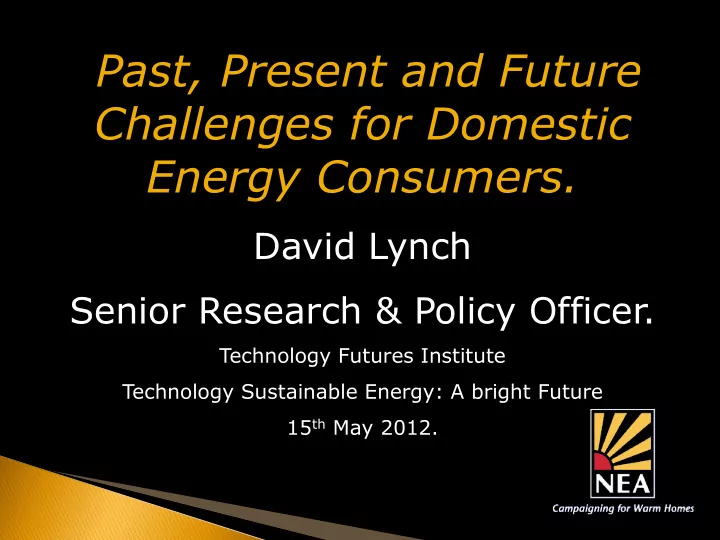

Past, Present and Future Challenges for Domestic Energy Consumers. David Lynch Senior Research & Policy Officer. Technology Futures Institute Technology Sustainable Energy: A bright Future 15 th May 2012.
Presentation outline A little bit about NEA. Domestic Energy Consumers. Past challenges. Present Challenges. Future Challenges. Close.
NEA : “NEA is the national energy efficiency charity that campaigns to eradicate fuel poverty and achieve affordable warmth for low-income households through increased investment in domestic energy efficiency.”
NEA: A little bit about us! • Established over 30 years ago! • Head office in Newcastle upon Tyne. • Employ approximately 60 staff. • National campaigning and lobbying organisation. • We achieve our objectives through:
NEA: Key Activities research and analysis into the causes and extent of fuel poverty. develop policies which will address the problem. provide advice and guidance to stakeholders on good practice in delivering energy efficiency services to low- income householders. Develop national qualifications to improve standards of practical work and the quality of energy advice. manage demonstration projects which show innovative ways of tackling fuel poverty and bring the wider benefits of energy efficiency to local communities.
Fuel Poverty Statistics 2011 2009 2011 Total Total COUNTRY Households In Percentage Households in percentage FP FP 5,314,655 ENGLAND 3,963,923 18.4% 24.7% WALES* 331,983 26.2% 425,161 33.5% SCOTLAND 733,010 31.5% 938,171 40.3% NORTHERN IRELAND 302,310 43.8% 358,877 49.4% GREAT BRITAIN 5,028,916 20.0% 6,677,987 26.6% 7,036,863 UK 5,331,226 20.6% 27.2%
Fuel Poverty Statistics 2011 2003-11 2008-11 Changes in average standard credit fuel prices since 2003 2003 2008 2011* % change Gas £330 £557 £781 137% 7% 40% Electricity £242 £365 £520 115% 5% 42% Dual fuel £572 £922 £1,294 126% 6% 40% NOTE: Average bills are based on annual consumptions of 16,500 kWh for gas, 3,300 kWh for electricity and are averaged across each regional distribution area to give a GB average. All prices include VAT @ 5%. * Dual fuel includes discount.
Breakdown kdown of Domestic estic Elect ctric ricit ity Bill: l: Meter Cost Transmission Costs 1% VAT 5% 5% Environment Costs 10% Wholesale energy, supply Distribution costs and profit Charges margin 17% 62% Source: Ofgem 2011
Political Drivers in CO2 Reduction In 2009, the Government published the UK Low Carbon Transition Plan which detailed the medium term actions to be taken to cut carbon emissions by 34% by 2020, based on 1990 levels (of which 21% has been achieved).
Present & Future Challenges and Opportunities: • Smart Meters • Big Renewable Generation. • New Loads (EV’s.) • Microgeneration (PV, Heat Pumps.)
Smart Metering Roll Out The Government has consulted on a Smart Metering Implementation Programme which seeks to roll out a smart meter to every home in Great Britain by 2020 or earlier and to ensure business and the public sector have ‘smart or advanced energy meters suited to their needs.’ Key components of the proposals include:
Smart Metering Roll Out • Energy suppliers are required to provide an ‘In - Home Display’ showing usage information for gas and electricity in pounds and pence and in kilowatt-hours. Electricity usage will be updated every five seconds. • Meters will allow supply to be controlled remotely. • Communication to and from smart meters in the domestic sector will be managed “Central Data Communications Entity” to be operating by autumn 2013.
Future developments
Future developments • Nuclear Generation. • Demand Side Response. • Smart Grids. • Renewables Generation. • Coal and Gas CCS.
“Demand Response: relates to any program which encourages shift of (demand) of energy by end consumers. The participation of the end customers is a response to factors such as incentive pricing, new tariff schemes, greater awareness and an increased sense of responsibility. The end consumers agree to involvement, but their participation may involve either active behavioural changes or passive responses, through the use of automation.”
What do consumers need to do to save money from DSR ? • Can we save most by moving load at : • Evening peak (5‐7 pm ) ? • Other times of day ? • Which customer groups can save most money from DSR ?
The Future Smart Grid... What is a smart grid? A smart grid is an electricity network which makes use of information and communications technologies, enabling more dynamic ‘real - time’ flows of information on the network and more interaction between suppliers and consumers.
The Future Smart Grid... Why is a smart grid desirable? A smart grid could play a major role in facilitating the decarbonisation of the electricity system by: • Reducing the requirement for greater peak generation capacity by enabling consumers to shift non time-critical demand to non- peak times. • Reducing the requirement for extensive transmission and distribution grid reinforcement by enabling better usage of existing networks. • Improving outage management by improving the information available to network companies. • Allowing large amounts of small -scale, intermittent renewables to be connected at the distribution grid level.
By 2030... 97% of electricity should be generated by low-carbon sources in 2030, compared to 26% now…
By 2030... Low-carbon capacity needs to be added to the system in 2020s – a mixture of nuclear, renewables and CCS.
By 2030... The carbon intensity of power will need to fall from around 500 g/kWh today to 50 g/kWh by 2030. Busy times ahead!
Thank you!
Recommend
More recommend